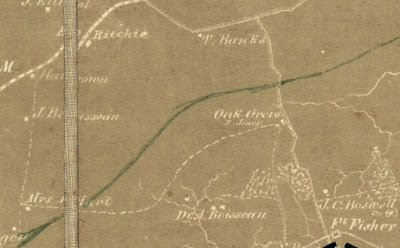When listing the various battles that occurred during the Petersburg Campaign, they often include "so-an-so's farm" as a mark of identity and location. There's the Battle of Baylor's Farm, the Battle of Peebles Farm, the Battle of Lewis Farm, and the Battle of Jones Farm. The military fighting that occurred on the fields and woodlots that covered these acres have received much more coverage than their original interned purpose of agricultural enterprise.
However, by doing a little basic research, one can gather quite a bit of information about the owners and the operation of these farms (or more accurately in many instances, plantations). Such was the case of Robert H. Jones's place, just southwest of Petersburg. The picture above shows part of land on which the Jones Farm once occupied.
Robert H. Jones was a tobacco inspector and planter. His home, "Oak Grove" was located along the west side of Church Road, but apparently the plantation encompassed both sides of road. In 1860, the fifty year old Jones had land holdings valued at $57,800, which consisted of 700 improved acres and 320 unimproved acres. He owned another $5000 in farming implements.
Jones's Oak Grove bordered the neighboring plantations of Mrs. Thomas Banks, Joseph G. Boisseau (brother in law), Albert W. Boisseau (brother-in-law), and J.C. Boswell. In the household along with Robert was his second wife, Ann E. Boisseau Jones, who Robert married around 1850. Mary was the sister of Robert's first wife, Martha Eliza T. Boisseau, who wed Jones in 1834, but died in 1840. Ann and Martha's mother, Athaliah Boisseau, also lived with the Jones couple, as well as nephew Adrian (twelve), the son of Robert's brother-in-law William E. Boisseau, who along with his wife, Julia, had died in Alabama in 1854. In addition, forty-five year old Thomas Ritcherson is included in the Jones home. Jones's personal property is listed at $57,000 and real estate at $10,000.
As one might imagine, Jones worked a large enslaved labor force on his one thousand plus acre plantation. The 1860 census lists him owning seventy-four men, women, and children, who lived in seventeen slave dwellings.
The 1860 agricultural census is a significant key to better understanding Oak Grove plantation at this time. As far as animals, enumerated were four horses, eighteen asses and mules, eight milk cows, and ten other cattle. That may sound like quite a small sum to help feed a plantation family and their enslaved workforce until one reads the following line of two hundred swine, which provided the bulk of the meat consumed on Southern plantations. All of Jones's livestock was valued at $5330.00.
Also listed were the crops grown on the plantation. They were: three hundred bushels of wheat, ten bushels of rye, 5500 bushels of Indian corn, three hundred bushels of oats. Also listed are 3000 pounds of tobacco, which seems like a very small amount to keep seventy-four slaves engaged. Perhaps Jones leased out some of his surplus slaves, but that is merely speculation on my part.
The Jones Farm endured fighting not once, but twice. Its first experience was during the Peebles Farm fighting, September 20-October 2, 1864. However, it was on March 25, 1865, that the Jones Farm endured it most significant combat, with the family home being among the engagement's causalities. The house was set ablaze by soldiers in the Union VI Corps when it was utilized by Confederate sharpshooters. The March 25 engagement will be the subject of a future post.
Present-day photograph of Jones Farm by the author on May 20, 2017.
Period map of Jones Farm location courtesy of the Library of Congress.









Tim, I would like to share some information with you about the March 25 fight
ReplyDeleteHi Bryce, I'd be happy for any additional information on the March 25 fight. My email is trtalbott@aol.com or you can call me at work.
DeleteThanks Tim for your information on Jone's Farm and the Petersburg campaign. My Great uncle, 1st Lt. John R. Pearson, 7th Reg't N.C.T. was killed there on Sept. 30, 1864 at aged 18 years and 6 months.
ReplyDeleteThank you for reading!
ReplyDeleteOne of my grandfathers was killed at Jones Farm during the Civil War. His name was Thomas M Petty from around Spartanburg, South Carolina. I welcome any information about this battle and the man killed there. Maree Waters, Greer, South Carolina. Thank you!
ReplyDelete